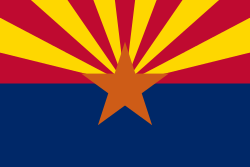Falcon Field (Arizona)
| Falcon Field Falcon Field Army Airfield | |||||||||||||||
|---|---|---|---|---|---|---|---|---|---|---|---|---|---|---|---|
|
USGS 2006 orthophoto | |||||||||||||||
| IATA: MSC – ICAO: KFFZ – FAA LID: FFZ | |||||||||||||||
| Summary | |||||||||||||||
| Airport type | Public | ||||||||||||||
| Owner | City of Mesa | ||||||||||||||
| Serves | Mesa, Arizona | ||||||||||||||
| Elevation AMSL | 1,394 ft / 425 m | ||||||||||||||
| Coordinates | 33°27′39″N 111°43′42″W / 33.46083°N 111.72833°W | ||||||||||||||
| Website | MesaAZ.gov/falcon_field/ | ||||||||||||||
| Map | |||||||||||||||
 FFZ Location in Arizona | |||||||||||||||
| Runways | |||||||||||||||
| |||||||||||||||
| Helipads | |||||||||||||||
| |||||||||||||||
| Statistics (2008) | |||||||||||||||
| |||||||||||||||
Falcon Field (IATA: MSC, ICAO: KFFZ, FAA LID: FFZ) is in Maricopa County, Arizona six miles northeast of Mesa, which owns it.[1] The National Plan of Integrated Airport Systems for 2011–2015 categorized it as a reliever airport.[2] Scheduled service to Bullhead City on Western Express Air ended in January 2007.[3]
Most U.S. airports use the same three-letter location identifier for the FAA and IATA, but Falcon Field is FFZ to the FAA[1] and MSC to the IATA.
Other services
Local companies:
- Alliant Techsystems (ATK)
- Boeing
- CAE Global Academy Phoenix
- Falcon Executive Aviation Inc.[4]
- Lockheed-Martin
- Marsh Aviation
- MD Helicopters
- Nammo Talley
- Semflex
- Special Devices Inc.
- Timken
- Trans-Matic
- Wal-Mart
Local groups:
Local museums:
- Commemorative Air Force Museum Arizona Wing[7]
Education:
- A campus of the Sabena Flight Academy is located on the airfield.
History

Falcon Field got its start before World War II when Hollywood producer Leland Hayward and pilot John H. "Jack" Connelly founded Southwest Airways with funding from friends like Henry Fonda, Fred Astaire, Ginger Rogers, James Stewart, Hoagy Carmichael and others. Southwest Airways operated two other airfields in Arizona -- Thunderbird Field No. 1 (now the site of Thunderbird School of Global Management) and Thunderbird Field No. 2 (now the site of Scottsdale Airport) -- to train pilots from China, Russia and 24 other Allied nations. Falcon was to be Thunderbird Field III and would train British pilots.
But the British said they'd like the field to be named after one of their birds, and thus Falcon Field opened as the No. 4 British Flying Training School (BFTS). There were six BFTS airfields in the U.S., in Florida, Oklahoma, Texas, California and Arizona.
In September 1941 the first cadets of the Royal Air Force arrived. They trained in Stearman PT-17s and North American Aviation AT-6s. The good weather, wide-open desert terrain, and lack of enemy airpower provided safer and more efficient training than was possible in England. Even so, twenty-three British cadets, one American cadet and four instructors were killed and are now buried in the Mesa City Cemetery, along with several colleagues who have since died of natural causes. Several thousand pilots were trained there until the RAF installation was closed at the end of the war. The City of Mesa purchased the field from the U.S. government for $1.
From 1945-65 the field was leased out to industrial interests, including Talley Defense Systems, Astro Rocket Inc., Rocket Power Inc., the Gabriel Company and others.
Eventually it became a civil airfield, and is now owned and operated by the city of Mesa. Falcon Field is the home of CAE Oxford Aviation Academy, the largest flight school in the world. Student pilots from Belgium, The Netherlands, the UK, Italy, Turkey and Vietnam fly out of Falcon Field. Since 1976 Falcon Field has been the home of Airbase Arizona, one of the largest units in the Commemorative Air Force (CAF) which operates a flying B-17G "Sentimental Journey" and a B-25J "Maid in the Shade" among other aircraft.
See also
- 36th Flying Training Wing (World War II)
- Arizona World War II Army Airfields
- List of airports in Arizona
Notes
- 1 2 3 FAA Airport Master Record for FFZ (Form 5010 PDF). Federal Aviation Administration. Effective April 5, 2012.
- ↑ "2011–2015 NPIAS Report, Appendix A" (PDF, 2.03 MB). National Plan of Integrated Airport Systems. Federal Aviation Administration. October 4, 2010. External link in
|work=(help) - ↑ "Press Release". Western Air Express. January 2007.
- ↑ falconaviation.com
- ↑ falconfieldarea.org
- ↑ falconfield.org
- ↑ arizonawingcaf.com
References
-
 This article incorporates public domain material from websites or documents of the Air Force Historical Research Agency.
This article incorporates public domain material from websites or documents of the Air Force Historical Research Agency. - Shaw, Frederick J. (2004), Locating Air Force Base Sites History’s Legacy, Air Force History and Museums Program, United States Air Force, Washington DC, 2004.
- Manning, Thomas A. (2005), History of Air Education and Training Command, 1942-2002. Office of History and Research, Headquarters, AETC, Randolph AFB, Texas ASIN: B000NYX3PC
- Bustrin, Mary Louise. My Second Job. Mesa, AZ: Mary Louise Bustrin, 1990.
- Dawson, Jim. The RAF in Arizona: Falcon Field, 1941-1945. Newnan, GA: Stenger-Scott Publishing, 2002.
- Mallett, Daryl F. Falcon Field. Charleston, SC: Arcadia Publishing, 2009.
- Simmons, Larry J. The Falcon Field Story. Scottsdale, AZ: Larry J. Simmons, 2002.
External links
| Wikimedia Commons has media related to Falcon Field (Arizona). |
- Falcon Field Airport web site
- Mesa ~ Falcon Field (FFZ) at Arizona DOT airport directory
- Falcon Field at VisitingPHX.com website
- Tango One Aviation, the fixed base operator (FBO)
- Aerial image as of July 1992 from USGS The National Map
- FAA Airport Diagram (PDF), effective February 4, 2016
- FAA Terminal Procedures for FFZ, effective February 4, 2016
- Resources for this airport:
- FAA airport information for FFZ
- AirNav airport information for FFZ
- FlightAware airport information and live flight tracker
- SkyVector aeronautical chart for FFZ
| ||||||||||||||||||||||||||||||||||||||||||||||||||||||||||
| ||||||||||||||||||



